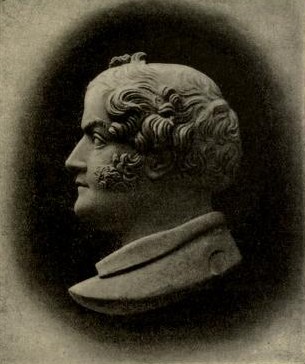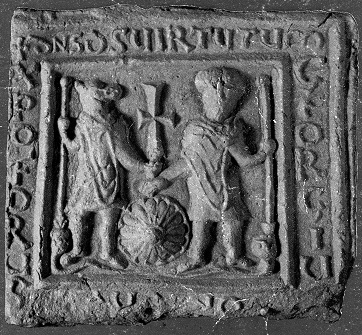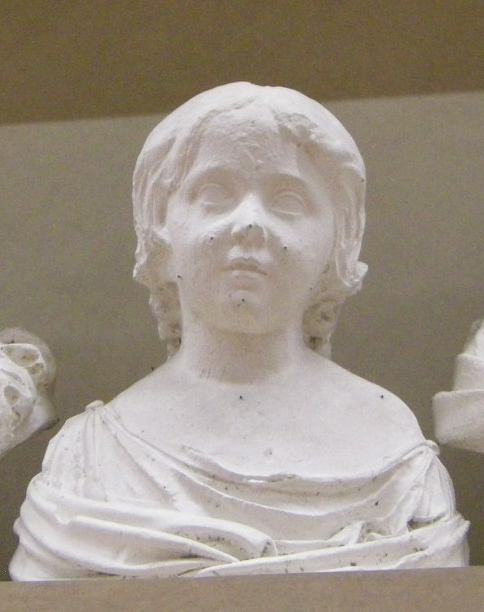|
Pistrucci
Benedetto Pistrucci (29 May 1783 – 16 September 1855) was an Italian gem-engraver, medallist and coin engraver, probably best known for his Saint George and the Dragon design for the British sovereign coin. Pistrucci was commissioned by the British government to create the large Waterloo Medal, a project which took him thirty years to complete. Born in Rome in 1783, Pistrucci studied briefly with other artists before striking out on his own at age 15. He became prominent as a cameo carver and was patronised by royalty. In 1815, he moved to Britain, where he would live for most of the rest of his life. His talent brought him to the attention of notables including William Wellesley-Pole, the Master of the Mint. Pole engaged Pistrucci to design new coinage, including the sovereign, which was first issued in 1817 to mixed reactions. Although Pole probably promised Pistrucci the post of Chief Engraver, the position could not be awarded as only a British subject could hold ... [...More Info...] [...Related Items...] OR: [Wikipedia] [Google] [Baidu] |
Waterloo Medal (Pistrucci)
The Waterloo Medal was designed by Italian-born sculptor Benedetto Pistrucci. He worked on it from 1819 to 1849, when the completed matrices were presented to Britain's Royal Mint. The medal was commissioned by the British Government in 1819 on the instructions of the Prince Regent (later George IV); copies were to be presented to the generals who had been victorious in the 1815 Battle of Waterloo, and to the leaders of Britain's allies. As most of the intended recipients had died by 1849, and relations with France had improved, the medals were never struck, though modern-day editions have been made for sale to collectors. In 1816, the Prince Regent had first suggested a medal to be presented to allies and commanders from Waterloo. The Royal Academy proposed work by John Flaxman, one of its members, but Pistrucci, whose responsibility it was to engrave the dies, refused to copy another's work, and brought forth designs of his own. The Prince Regent and William Wellesley-Pol ... [...More Info...] [...Related Items...] OR: [Wikipedia] [Google] [Baidu] |
Sovereign (British Coin)
The sovereign is a British gold coin with a nominal value of one pound sterling (£1) and contains 0.2354 troy oz of pure gold. Struck since 1817, it was originally a circulating coin that was accepted in Britain and elsewhere in the world; it is now a bullion coin and is sometimes mounted in jewellery. In addition, circulation strikes and proof examples are often collected for their numismatic value. In most recent years, it has borne the design of Saint George and the Dragon on the reverse; the initials () of the designer, Benedetto Pistrucci, are visible to the right of the date. The coin was named after the English gold sovereign, which was last minted about 1603, and originated as part of the Great Recoinage of 1816. Many in Parliament believed a one-pound coin should be issued rather than the 21-shilling guinea that was struck until that time. The Master of the Mint, William Wellesley Pole had Pistrucci design the new coin; his depiction was also used for other go ... [...More Info...] [...Related Items...] OR: [Wikipedia] [Google] [Baidu] |
Cameo (carving)
Cameo () is a method of carving an object such as an engraved gem, item of jewellery or vessel. It nearly always features a raised (positive) relief image; contrast with intaglio, which has a negative image. Originally, and still in discussing historical work, cameo only referred to works where the relief image was of a contrasting colour to the background; this was achieved by carefully carving a piece of material with a flat plane where two contrasting colours met, removing all the first colour except for the image to leave a contrasting background. A variation of a carved cameo is a cameo incrustation (or sulphide). An artist, usually an engraver, carves a small portrait, then makes a cast from the carving, from which a ceramic type cameo is produced. This is then encased in a glass object, often a paperweight. These are very difficult to make but were popular from the late 18th century through the end of the 19th century. Originating in Bohemia, the finest examples were mad ... [...More Info...] [...Related Items...] OR: [Wikipedia] [Google] [Baidu] |
Cameo (carving)
Cameo () is a method of carving an object such as an engraved gem, item of jewellery or vessel. It nearly always features a raised (positive) relief image; contrast with intaglio, which has a negative image. Originally, and still in discussing historical work, cameo only referred to works where the relief image was of a contrasting colour to the background; this was achieved by carefully carving a piece of material with a flat plane where two contrasting colours met, removing all the first colour except for the image to leave a contrasting background. A variation of a carved cameo is a cameo incrustation (or sulphide). An artist, usually an engraver, carves a small portrait, then makes a cast from the carving, from which a ceramic type cameo is produced. This is then encased in a glass object, often a paperweight. These are very difficult to make but were popular from the late 18th century through the end of the 19th century. Originating in Bohemia, the finest examples were mad ... [...More Info...] [...Related Items...] OR: [Wikipedia] [Google] [Baidu] |
Saint George And The Dragon
In a legend, Saint Georgea soldier venerated in Christianitydefeats a dragon. The story goes that the dragon originally extorted tribute from villagers. When they ran out of livestock and trinkets for the dragon, they started giving up a human tribute once a year. This was acceptable to the villagers until a princess was chosen as the next offering. The saint thereupon rescues the princess chosen as the next offering. The narrative was first set in Cappadocia in the earliest sources of the 11th and 12th centuries, but transferred to Libya in the 13th-century ''Golden Legend''.St. George and the Dragon: Introduction in: E. Gordon Whatley, Anne B. Thompson, Robert K. Upchurch (eds.), ''Saints' Lives in Middle Spanish Collections'' (2004). The ... [...More Info...] [...Related Items...] OR: [Wikipedia] [Google] [Baidu] |
Benedetto Pistrucci, Bacco, Sardonice, 1800 Ca
Benedetto is a common Italian name, the equivalent of the English name Benedict. Notable people named Benedetto include: People with the given name * Benedetto Accolti (other), several people * Benedetto Aloi (1935–2011), American mobster * Benedetto Antelami (c. 1150–c. 1230), Italian architect and sculptor * Benedetto Bonfigli (c. 1420–c. 1490), Italian painter * Benedetto Bordone (1460–1531), Italian manuscript editor, miniaturist and cartographer * Benedetto Brin (1833–1898), Italian naval administrator and politician * Benedetto Cairoli (1825–1889), Italian statesman * Benedetto Castelli (1578–1643), Italian mathematician * Benedetto Cotrugli (1416–1469), Ragusan merchant, economist, scientist, diplomat and humanist * Benedetto Croce (1866–1952), Italian philosopher and politician * Benedetto da Maiano (1442–1497), Italian sculptor * Benedetto Della Vedova (born 1962), Italian politician * Benedetto Dei (1417–1492), Italian poet and hist ... [...More Info...] [...Related Items...] OR: [Wikipedia] [Google] [Baidu] |
Benedetto Pistrucci, Menade, Sardonice, 1810 Ca
Benedetto is a common Italian name, the equivalent of the English name Benedict. Notable people named Benedetto include: People with the given name * Benedetto Accolti (other), several people * Benedetto Aloi (1935–2011), American mobster * Benedetto Antelami (c. 1150–c. 1230), Italian architect and sculptor * Benedetto Bonfigli (c. 1420–c. 1490), Italian painter * Benedetto Bordone (1460–1531), Italian manuscript editor, miniaturist and cartographer * Benedetto Brin (1833–1898), Italian naval administrator and politician * Benedetto Cairoli (1825–1889), Italian statesman * Benedetto Castelli (1578–1643), Italian mathematician * Benedetto Cotrugli (1416–1469), Ragusan merchant, economist, scientist, diplomat and humanist * Benedetto Croce (1866–1952), Italian philosopher and politician * Benedetto da Maiano (1442–1497), Italian sculptor * Benedetto Della Vedova (born 1962), Italian politician * Benedetto Dei (1417–1492), Italian poet and historia ... [...More Info...] [...Related Items...] OR: [Wikipedia] [Google] [Baidu] |
Caroline Bonaparte
Carolina Maria Annunziata Bonaparte Murat Macdonald (French: ''Caroline Marie Annonciade Bonaparte''; 25 March 1782 – 18 May 1839), better known as Caroline Bonaparte, was an Imperial French princess; the seventh child and third daughter of Carlo Buonaparte and Letizia Ramolino, and a younger sister of Napoleon I of France. She was queen of Naples during the reign of her spouse there, and regent of Naples during his absence four times: in 1812-1813, 1813, 1814, and 1815. In 1800, Caroline married Joachim Murat Jordy, Marshal of the Empire, Prince Murat and later King of Naples, one of Napoleon's most important and notorious generals. Early years Caroline was born in Ajaccio, Corsica to Carlo Bonaparte and Letizia Ramolino. She was a younger sister of Joseph Bonaparte, Napoléon Bonaparte, Lucien Bonaparte, Elisa Bonaparte, Louis Bonaparte, and Pauline Bonaparte. She was an older sister of Jérôme Bonaparte. Highly regarded for her beauty and intelligence, Caroline was al ... [...More Info...] [...Related Items...] OR: [Wikipedia] [Google] [Baidu] |
Capitoline Hill
The Capitolium or Capitoline Hill ( ; it, Campidoglio ; la, Mons Capitolinus ), between the Forum and the Campus Martius, is one of the Seven Hills of Rome. The hill was earlier known as ''Mons Saturnius'', dedicated to the god Saturn. The word ''Capitolium'' first meant the temple of Jupiter Optimus Maximus later built here, and afterwards it was used for the whole hill (and even other temples of Jupiter on other hills), thus ''Mons Capitolinus'' (the adjective noun of ''Capitolium''). In an etymological myth, ancient sources connect the name to ''caput'' ("head", "summit") and the tale was that, when laying the foundations for the temple, the head of a man was found, some sources even saying it was the head of some ''Tolus'' or ''Olus''. The ''Capitolium'' was regarded by the Romans as indestructible, and was adopted as a symbol of eternity. By the 16th century, ''Capitolinus'' had become ''Capitolino'' in Italian, and ''Capitolium'' ''Campidoglio''. The Capitoline Hill ... [...More Info...] [...Related Items...] OR: [Wikipedia] [Google] [Baidu] |
Elisa Bonaparte
Maria Anna Elisa Bonaparte Baciocchi Levoy (French language, French: ''Marie Anne Elisa Bonaparte''; 3 January 1777 – 7 August 1820), better known as Elisa Bonaparte, was an imperial French princess and sister of Napoleon, Napoleon Bonaparte. She was Principality of Lucca and Piombino, Princess of Lucca and Piombino (1805-1814), Grand Duchess of Tuscany (1809-1814) and Countess of Compignano by appointment of her brother. She was the fourth surviving child and eldest surviving daughter of Carlo Buonaparte and Letizia Ramolino. A younger sister of Napoleon, Napoleon Bonaparte, she had elder brothers Joseph Bonaparte, Joseph and Lucien Bonaparte, Lucien, and younger siblings Louis Bonaparte, Louis, Pauline Bonaparte, Pauline, Caroline Bonaparte, Caroline and Jérôme Bonaparte, Jerome. As Princess of Lucca and Piombino, then Grand Duchess of Tuscany, she became Napoleon's only sister to possess political power. Their relations were sometimes strained due to her sharp tongue. Hi ... [...More Info...] [...Related Items...] OR: [Wikipedia] [Google] [Baidu] |
Pauline Bonaparte
Paula Maria Bonaparte Leclerc Borghese ( French: ''Pauline Marie Bonaparte''; 20 October 1780 – 9 June 1825), better known as Pauline Bonaparte, was an imperial French princess, the first sovereign Duchess of Guastalla, and the princess consort of Sulmona and Rossano. She was the sixth child of Letizia Ramolino and Carlo Buonaparte, Corsica's representative to the court of King Louis XVI of France. Her elder brother, Napoleon, was the first emperor of the French. She married Charles Leclerc, a French general, a union ended by his death in 1802. Later, she married Camillo Borghese, 6th Prince of Sulmona. Her only child, Dermide Leclerc, born from her first marriage, died in childhood. She was the only Bonaparte sibling to visit Napoleon in exile on his principality, Elba. Early life Maria Paola Buonaparte, the sixth child of Letizia Ramolino and Carlo Maria Buonaparte, Corsica's representative to the court of King Louis XVI of France, was born on 20 October 1780 in Ajaccio, ... [...More Info...] [...Related Items...] OR: [Wikipedia] [Google] [Baidu] |
Cameo Of Benedetto Pistrucci
Cameo or CAMEO may refer to: * Cameo appearance, a brief appearance of a known figure in a film or television show * Cameo (carving), a method of carving, making use of layers of different colours, or an item made with such a method Music * ''Cameo'' (album), an album by Dusty Springfield * Cameo (band), an American funk group * Cameo Records, a 1920s New York-based record label * DJ Cameo, a British disc jockey and radio presenter * "Cameo", a song by Devo from ''Something for Everybody'' * "Cameo", a 2015 song by Momus from '' Turpsycore'' Places * Cameo, California, a community * Cameo, Colorado, a ghost town * Cameo, West Virginia Other uses * Cameo (apple), a cultivar of apple * Cameo (coinage), a finish evaluated in the process of coin grading * CAMEO (database), ''Conservation and Art Materials Encyclopedia Online'', a Museum of Fine Arts, Boston database of technical terms used in art conservation and historic preservation * CAMEO (satellite), an experiment ... [...More Info...] [...Related Items...] OR: [Wikipedia] [Google] [Baidu] |








